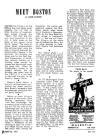
Home Page Meet Boston Menu Index
|
MEET BOSTON Friday, May 23, 1941 in What's New In Town W. J. Sidis |
Before the filling in of the Back Bay had made much progress, the city had no other direction of expansion open except through the “Neck” that then was the only land connection of the city. A hotel arose on the Neck at this period, called the St. James. The name of James Street commemorates this old-time hotel, while the park in front of the hotel became Franklin Square. In the Seventies, this building was taken over by the New England Conservatory of Music, then recently formed, as a building large enough for classes and dormitories under the same roof. When the Conservatory moved to its present location, the old building was taken over by the Y. M. C. A. It is now back in the hotel business, as the Franklin Square House.
*
Boston’s South Station is the only railroad station containing two postal stations, both directly accessible from the passenger concourse without going outdoors.
*
Before so much filling in was done on the banks of the Charles, Lechmere’s Point (now East Cambridge) was a swampy point of land sticking out into the river on the Cambridge side. As it was an isolated section of Middlesex, remote from the rest of the county, it was a convenient landing point for the British military expedition which set out from Boston to raid the rebels in Middlesex on the morning of [Wednesday] April 19, 1775―and whose hurried retreat a few hours later started the Revolution. For similar geographical reasons, the Middlesex courts, when driven out of Concord in December, 1786, by the Says Rebellion, took refuge in Lechmere’s Point―and are still there. The filling-in of the shore has obliterated the Point, but its name survives in Lechmere Square and Lechmere Station.
*
The “station plaza”―a wide, open square serving for entrance to a railroad depot―was originally a Boston idea. Over a hundred years ago, both Park Square and Haymarket Square arose in that way. Dewey Square at present serves the same purpose; and its name indicates the time South Station was built.
*
At 175 Washington Street (between Court Street and Alams Square) is a place that looks something like a bank. It has a fancy Commonwealth shield on each window, and it carries signs indicating that it is a State “liquidation” might be something dangerous in some countries, here in Boston it only indicates the place where the State handles the affairs of closed banks. The place used to be Paul Revere’s goldsmith shop―where he also did some miscellaneous engraving on the side. Among other things it was there that Paul Revere engraved the first American paper money, issue by the “State of Massachusetts Bay,” in the early days of the Revolution.
*
America’s first bank was in Boston, at the location of the present Rogers-Peet store on Tremont Street. Originally a “bootleg” textile works, before the Revolution, when English regulations prohibited all manufacturing in America, the building then located at that place became known during the Revolution as “Manufactory House.” Like most of these bootleg pre-Revolution industries in Massachusetts, it was foreclosed by groups of creditors after the advent of the Commonwealth in 1780, and these money groups established in “Manufactory House” the first bank in America in 1784, the Massachusetts Bank. It became a storm center of the Shays Rebellion in 1786, against which the rebellion was directed. Some sixty years ago, this bank was merged into the First National Bank.